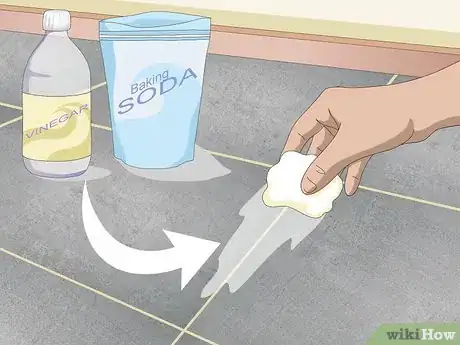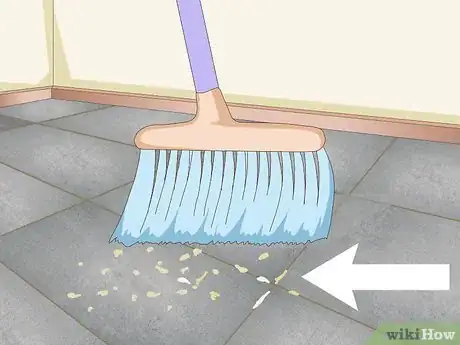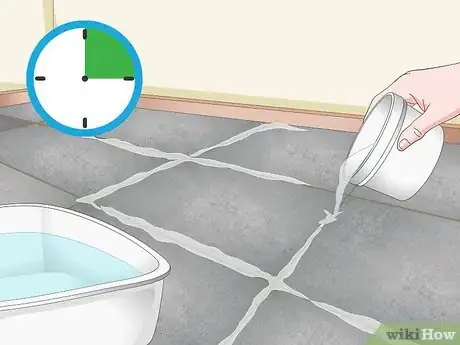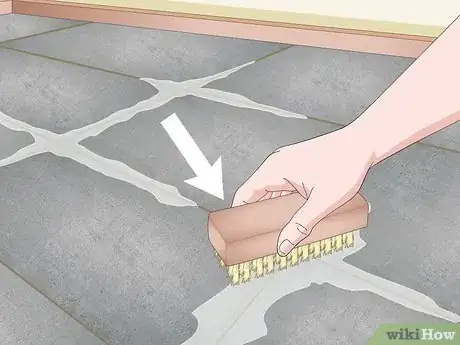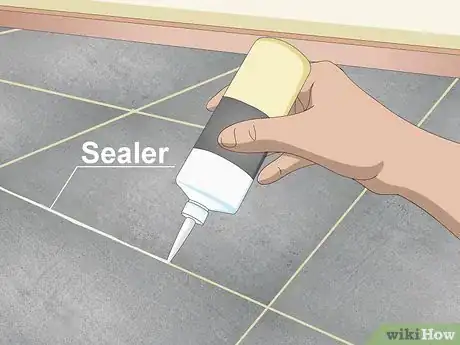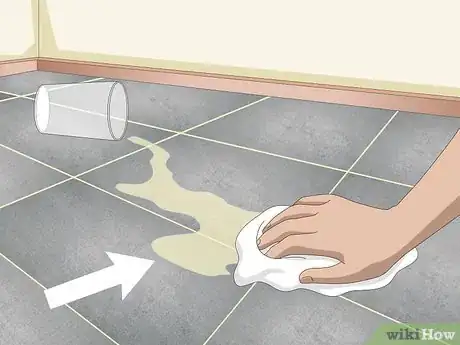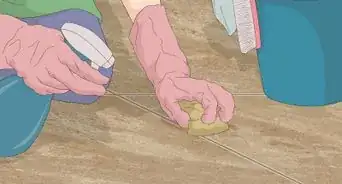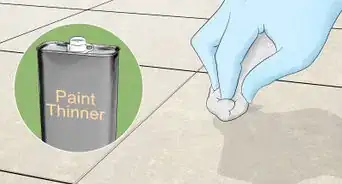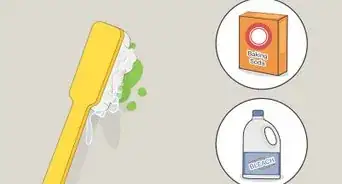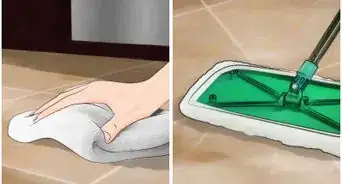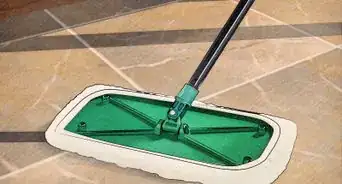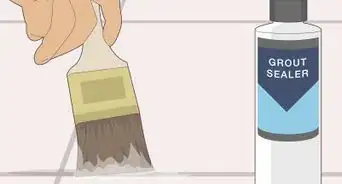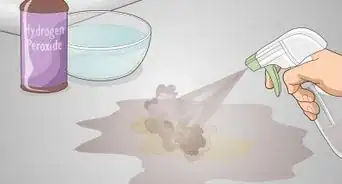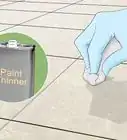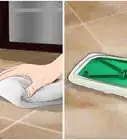This article was co-authored by Michelle Driscoll, MPH. Michelle Driscoll is the Owner of Mulberry Maids, which is based in Fort Collins, Colorado. With five years of experience, her business specializes in cleaning homes and small offices. She holds a Masters in Public Health from the Colorado School of Public Health. Additionally, Mulberry Maids has an A+ rating from the Better Business Bureau.
This article has been viewed 66,000 times.
Colored grout may be designed to match the color of your tiles, contrast with tiles or provide a neutral backdrop. Regardless of the color of your grout, you will need to take measures to keep it vibrant and aesthetically pleasing. Keeping your colored grout clean begins with the application of a sealer and includes both regular and deep cleaning.[1]
Steps
Choosing a Cleaning Solution
-
1Use a steam cleaner. Steam cleaners use heat and high pressure to get rid of debris. However, if your grout is very old or damaged, you should avoid using a steam cleaner because it may cause further damage. Heat the steam cleaner and then move the cleaning wand along the surface of the grout lines to get rid of any dirt and debris.[2]
-
2Start with a mild cleaning solution. It is best to try mild solutions first, since they are least likely to damage your colored grout. Start by trying vinegar or baking soda. If that doesn’t do the job, you can move on to hydrogen peroxide, which will work with moderate levels of grime. If your grout lines are really grimy, you may need to use oxygen bleach. However, chlorine bleach should generally be avoided.[3]
- Chlorine bleach will discolor your colored grout, so you should leave it in the cupboard. Instead, choose either hydrogen peroxide or oxygen bleach.
- If your colored grout is dirty around dishwashers or sinks from hard-water deposits, you can use a vinegar solution. In a spray bottle, pour an equal amount of vinegar and water. Spray a bit of the solution on the grout lines. Then, scrub the grout lines with your grout brush. If you don't have a grout brush, a toothbrush will also work.[4]
- If vinegar alone isn't working, a good alternative is a baking soda and vinegar mix. Wet baking soda with just enough water to make a thick paste. Apply the paste to your grout, then spray it with vinegar. Let the solution sit until it stops bubbling, then scrub the area with a brush. Rinse with clean water and dry with a rag.[5]
Advertisement -
3Use oxygen bleach sparingly. Although oxygen bleach does a great job on colored grout, it will eventually wear the color down because of the chlorine.[6] The main advantage of oxygen bleach is that it requires very minimal scrubbing and does not produce fumes. You can find it at most home, hardware and cleaning supply stores.[7]
Applying the Solution and Scrubbing
-
1Get rid of surface debris. Start by sweeping the floor, wiping off the countertop, walls or other tiled surface. Then, rinse off the surface of the grout to remove surface dirt and debris.[8]
-
2Mix the cleaning solution with warm water. Following the directions on the cleaning product, mix your cleaning solution. If you are cleaning a counter, you can use a small plastic bowl. If you are cleaning your floor, you should mix it in your mop bucket.[9]
-
3Flood the grout lines with the cleaning solution. You will notice that grout lines are slightly depressed from the surface of your counter or floor. Fill these depressions with the cleaning solution and then let it sit for at least fifteen minutes.[10]
-
4Scrub the grout. After letting the cleaning solution sit for fifteen minutes, use your grout brush to scrub away the grime. Since the cleaning solution will break down dirt molecules, it should be easy to remove them with a gentle scrub.[11]
-
5Mop the floor with a cleaning solution. If you are cleaning a floor, you can add a cleaning solution, such as vinegar or oxygen bleach powder, to your mop water. Mop the floor with a liberal amount of the cleaning solution. Then, let it sit for thirty minutes. Finally, put fresh water in your mop bucket and rinse the floor.[12]
- If you use vinegar, mix equal parts warm water and vinegar.
Using Preventative Measures
-
1Apply a penetrating sealer to your colored grout. A sealer will make your colored grout stain-resistant, since it makes the grout more resistant to oil- and water-based products. If your grout is very soiled, you could also re-apply the color sealant originally used to color the grout.
- Depending on the amount of wear and tear and the type of sealant you choose, you will need to re-apply it every year or two.
- If you are not sure whether your grout is sufficiently sealed, drip some water on it. If the water stays on the surface of the grout, it is sufficiently sealed. However, if the grout absorbs the water, you need to reseal the grout.
- When you purchase the sealer, ask if it is both hydrophobic and oleophobic. Some sealers are only water-repelling or hydrophobic, whereas others will repel both water and oil-based substances.
-
2Wipe up spills right away. When coffee or soda spills on your colored grout, you should wipe it up right away. This will reduce the amount of work involved in cleaning the grout.
-
3Wipe down your shower tiles after showering. When you finish your shower, use a squeegee to quickly wipe down your shower tiles. This will prevent the accumulation of lime, soap deposits and rust stains on your colored grout.
Community Q&A
-
QuestionWill baking soda and vinegar damage my black tiles?
 Samantha ClarkCommunity AnswerIf not properly washed, the addition of vinegar and baking soda will leave lumps on the tile floors. Also, don't leave the vinegar on the floor for too long. It's essential to rinse it off the floor with warm water.
Samantha ClarkCommunity AnswerIf not properly washed, the addition of vinegar and baking soda will leave lumps on the tile floors. Also, don't leave the vinegar on the floor for too long. It's essential to rinse it off the floor with warm water. -
QuestionHow to clean old urine stains from grout?
 Samantha ClarkCommunity AnswerWash the stain with a cloth dipped in warm sudsy water. If any stain remains, dip a wet toothbrush into baking soda or powdered cleanser and gently scrub the stain. Rinse well and wipe dry.
Samantha ClarkCommunity AnswerWash the stain with a cloth dipped in warm sudsy water. If any stain remains, dip a wet toothbrush into baking soda or powdered cleanser and gently scrub the stain. Rinse well and wipe dry. -
QuestionHave you ever heard that vinegar damages grout so that it needs to be resealed? I have colored grout in my bathroom and want to make my own tile/grout cleaner. Use vinegar or hydrogen peroxide? Thanks
 Samantha ClarkCommunity AnswerUse hydrogen peroxide. Need a recipe? Mix together 1/2 cup of baking soda, 1/4 cup of hydrogen peroxide, and 1 tsp dish soap. Apply cleaning mixture onto the grout, wait 5-10 minutes, then scrub and rinse. All done!
Samantha ClarkCommunity AnswerUse hydrogen peroxide. Need a recipe? Mix together 1/2 cup of baking soda, 1/4 cup of hydrogen peroxide, and 1 tsp dish soap. Apply cleaning mixture onto the grout, wait 5-10 minutes, then scrub and rinse. All done!
Things You’ll Need
- Steam cleaner
- Grout brush or toothbrush
- Oxygen bleach powder
- pH-neutral cleaner
- Squeegee
- Alkaline cleaner
- Grout restorer
References
- ↑ http://www.washingtonpost.com/wp-dyn/content/article/2009/04/03/AR2009040302977.html
- ↑ https://pro.com/blog/ways-to-clean-tile-grout/
- ↑ https://www.bobvila.com/articles/cleaning-grout/#.WnqIOxIrLeQ
- ↑ http://articles.chicagotribune.com/2004-08-27/business/0408270384_1_grout-chlorine-bleach-hydrogen-peroxide
- ↑ https://pro.com/blog/ways-to-clean-tile-grout/
- ↑ https://pro.com/blog/ways-to-clean-tile-grout/
- ↑ http://www.washingtonpost.com/wp-dyn/content/article/2009/04/03/AR2009040302977.html
- ↑ http://www.cleanandscentsible.com/2015/09/how-to-clean-grout.html
- ↑ http://www.washingtonpost.com/wp-dyn/content/article/2009/04/03/AR2009040302977.html
About This Article
If your colored grout’s looking a little worse for wear, you can clean it with some ingredients you probably already have at home. First, mix equal amounts of vinegar and water in a spray bottle. Then, spray your grout lines and scrub them with a grout brush or an old toothbrush. If the grout’s still not as clean as you’d like, try mixing baking soda with a little water until it forms a thick paste. Then, apply the paste to the grout, spray it with your vinegar solution, and scrub it again. To get rid of really tough stains, sprinkle a little oxygen bleach onto your grout and scrub it lightly. Only use this as a last resort, since oxygen bleach will wear down the color of your grout. For more tips from our Cleaning co-author, including how to seal your grout to keep it clean for longer, read on!

